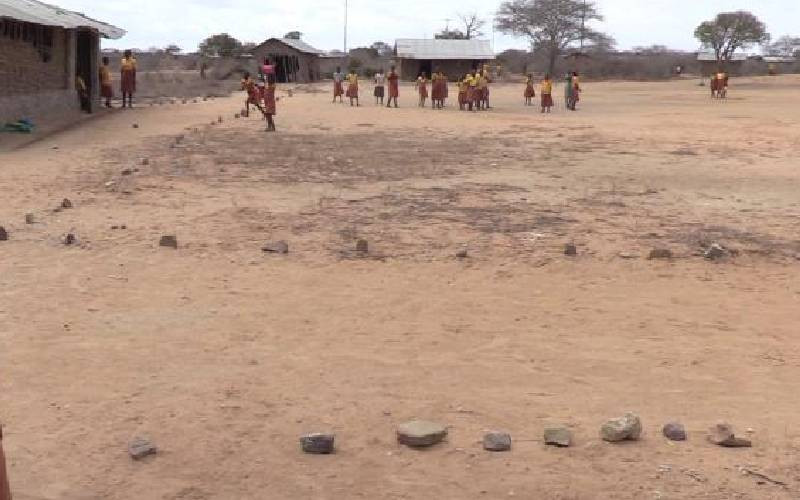
As drought continues to ravage the country due to the ripple effect of climate change, it is feared that over 3.5 million children in Kenya will be out of school when schools reopen for the first term next week.
A study by the Global Out of School Children Initiative has revealed that there are more than two million children aged between 4 and 17 years who have been out of school since the third term of 2021.
The Long rains assessment report by the National Disaster Management Authority projects that an additional 1.6 million children are at high risk of dropping out of school as schools reopen for the first term and as the hunger crisis worsens.
Among the worst-hit counties include Mandera, Garissa, Wajir, Turkana and Marsabit, with Mandera having the highest number of school dropouts of 295,470 children aged between four and seventeen years old, followed by Garissa follows with 289,410, Wajir at 266,540, and 253,640 cases in Turkana at 253,640 and 107,600 recorded in Marsabit.
Other counties also greatly affected by school dropouts are Narok with 83,020, West Pokot with 80,070, and Samburu with 64,818 school dropouts.
The 2022 long rains assessment, October to December projection period report for the Arid and Semi-Arid Land (ASAL) region indicate that 4.35 million people in Kenya are facing high levels of acute food insecurity.
According to a recent survey done by Save the Children in June 2022 on the impact of the drought in 17 counties, a significant decrease in enrollment is seen in all the counties with an average of 52 percent affected schools across all levels (Early Childhood Education, Primary and Secondary).
Among the key reasons for high school dropouts are inadequate or lack of school meals, poor learning environment, and lack of teachers, dilapidated infrastructure, resource-based conflicts, and climate-related emergencies. Shortage of water in schools is also a major factor.
- Parents, educators urged to encourage play to boost learning
- Japanese firm, UNICEF partner to boost sanitation and hygiene
Keep Reading
An analysis of water in primary and secondary schools at the 17 counties targeted by the education sector revealed that 460 schools have no water source and 1,896 schools only rely on harvesting rainwater.
"Kenya is experiencing one of the worst droughts in 40 years. Children are the most vulnerable groups and are usually the most affected in such emergencies. Parents have to migrate with their children in search of food, pasture, and water for their livestock. This compromises their access to basic facilities such as food, clean water, healthcare and education," said Yvonne Arunga, Country Director for Save the Children Kenya and Madagascar.
Northern Kenya is majorly a pastoralist community and right now, parents are unable to pay school fees because they have lost their sources of livelihood.
Communities are majorly focused on basic survival skills, and school-going children have to help their parents take care of livestock and carry out domestic chores.
"Every minute that goes by means more children's lives are increasingly at risk. Time is quickly running out for children. They're missing out on education, making them more disadvantaged.
We are calling on the government to make every effort to ensure maximized and efficient running of school feeding programs during drought situations, especially in the areas worst affected by drought. Most of these children depend on these meals," said Ms Arunga.
Save the Children is also calling on the government to ensure there is adequate supply of safe water to schools during the drought for purposes of drinking, sanitation and personal hygiene in order to enhance a conducive school environment that will encourage children to stay in school. The government should also put in place real-time monitoring systems to assess situations in schools at the onset of drought to enable early responses before the impact school closures is experienced.
To address these gaps in education, Save the Children is implementing the Operation Come to School Project dubbed 'Watoto rudi Shule' to increase enrolment and retention of children who are out of school in Wajir Turkana, Baringo and Bungoma Counties.
The organisation will work in partnership with the various departments - Ministry of Education, Teachers Service Commission, Youth, Gender and Social Service Department, County Directorate of Education Office and Public Health as well as other education stakeholders in the targeted Counties. This will ensure complementarity with county-level priorities and project education priorities in the proposed project.
Not only are school dropouts anticipated, but a UNICEF report released in October last year also noted that failed rainfall in Kenya has left about 1.4 million children with reduced access to nutritious food, and safe drinking water.
The children, according to UNICEF, are not able to access education, health services, and protection from violence and neglect. Kenya is reported to have experienced four failed rainy seasons.
Even as locals in drought-hit areas starve, UNICEF observed that a predicted fifth poor rainy season is expected to worsen the situation, leading to more children and families needing humanitarian assistance.
 The Standard Group Plc is a multi-media organization with investments in media platforms spanning newspaper print
operations, television, radio broadcasting, digital and online services. The Standard Group is recognized as a
leading multi-media house in Kenya with a key influence in matters of national and international interest.
The Standard Group Plc is a multi-media organization with investments in media platforms spanning newspaper print
operations, television, radio broadcasting, digital and online services. The Standard Group is recognized as a
leading multi-media house in Kenya with a key influence in matters of national and international interest.











